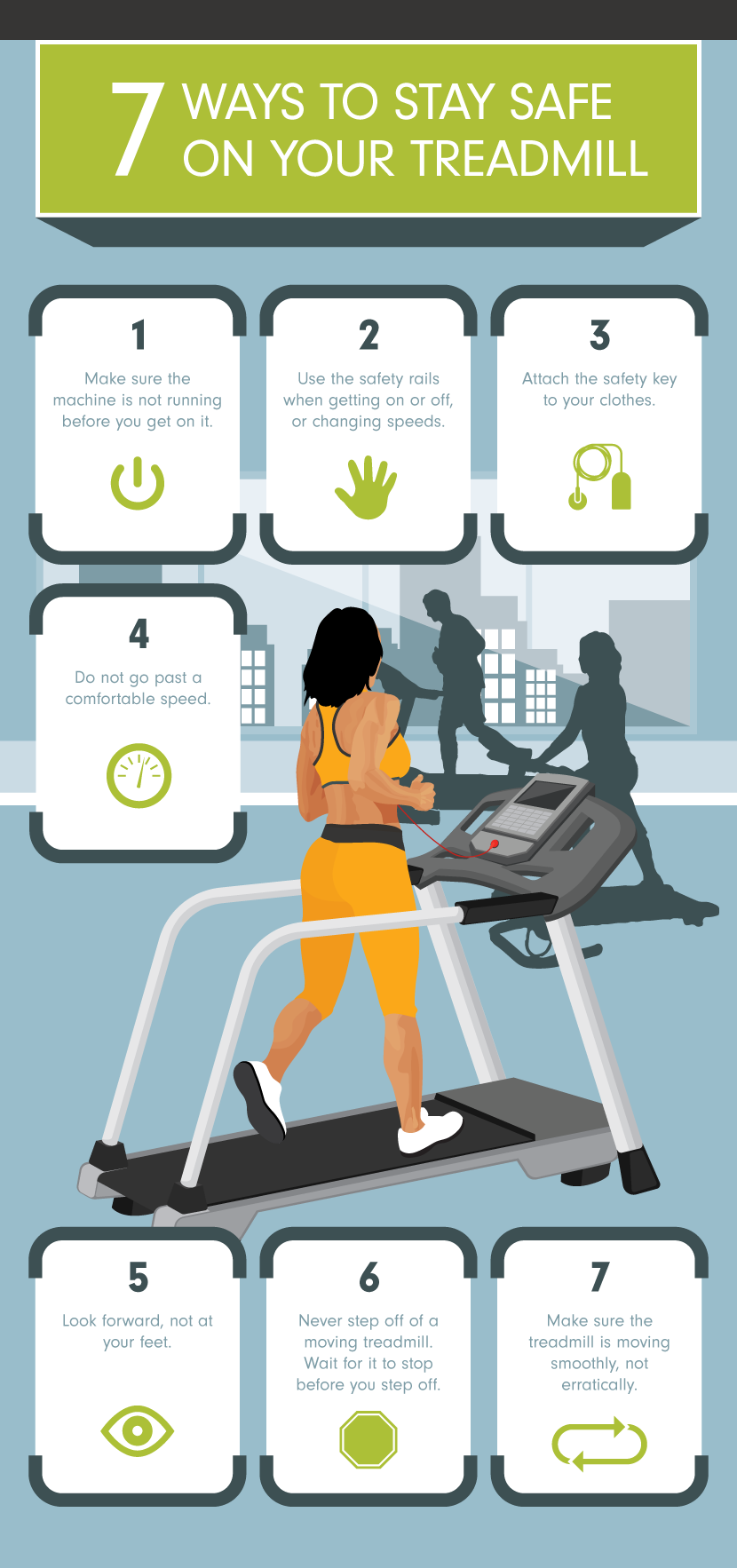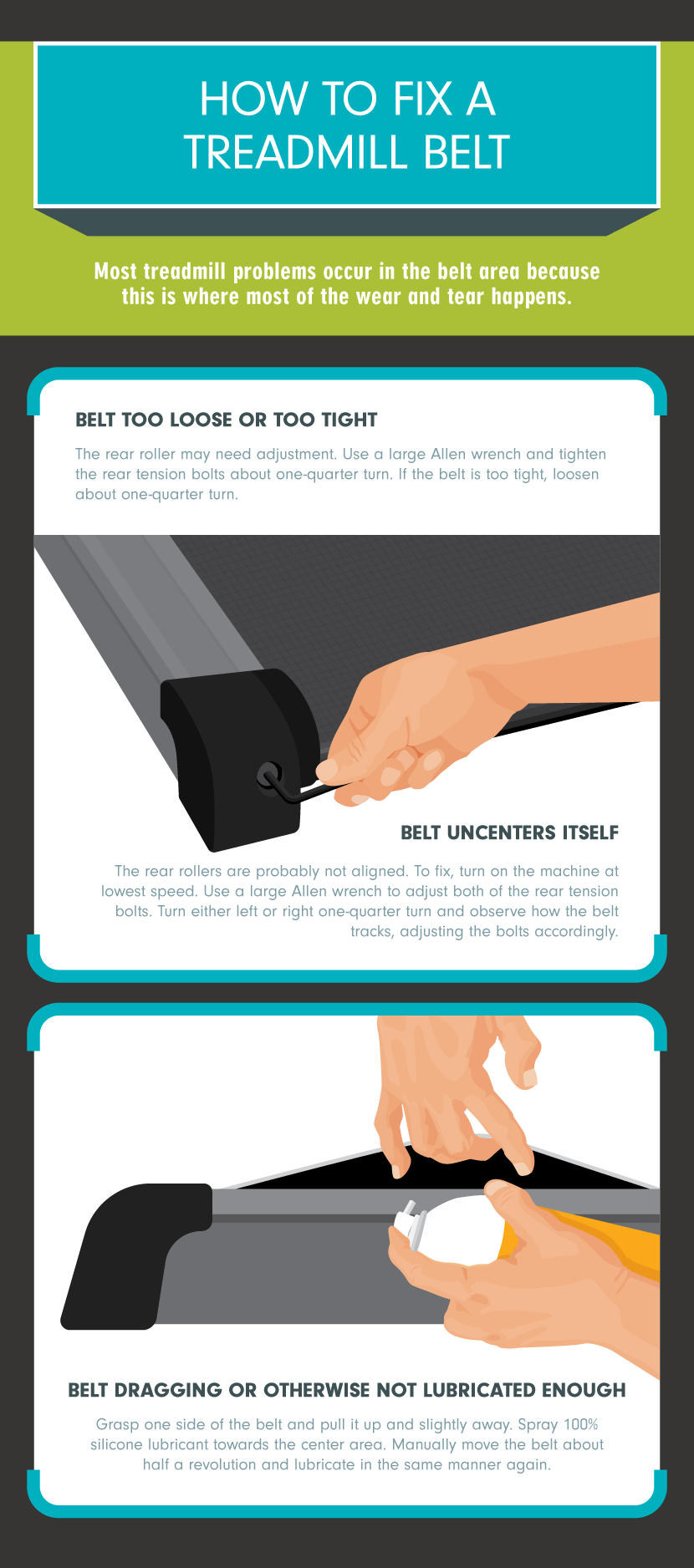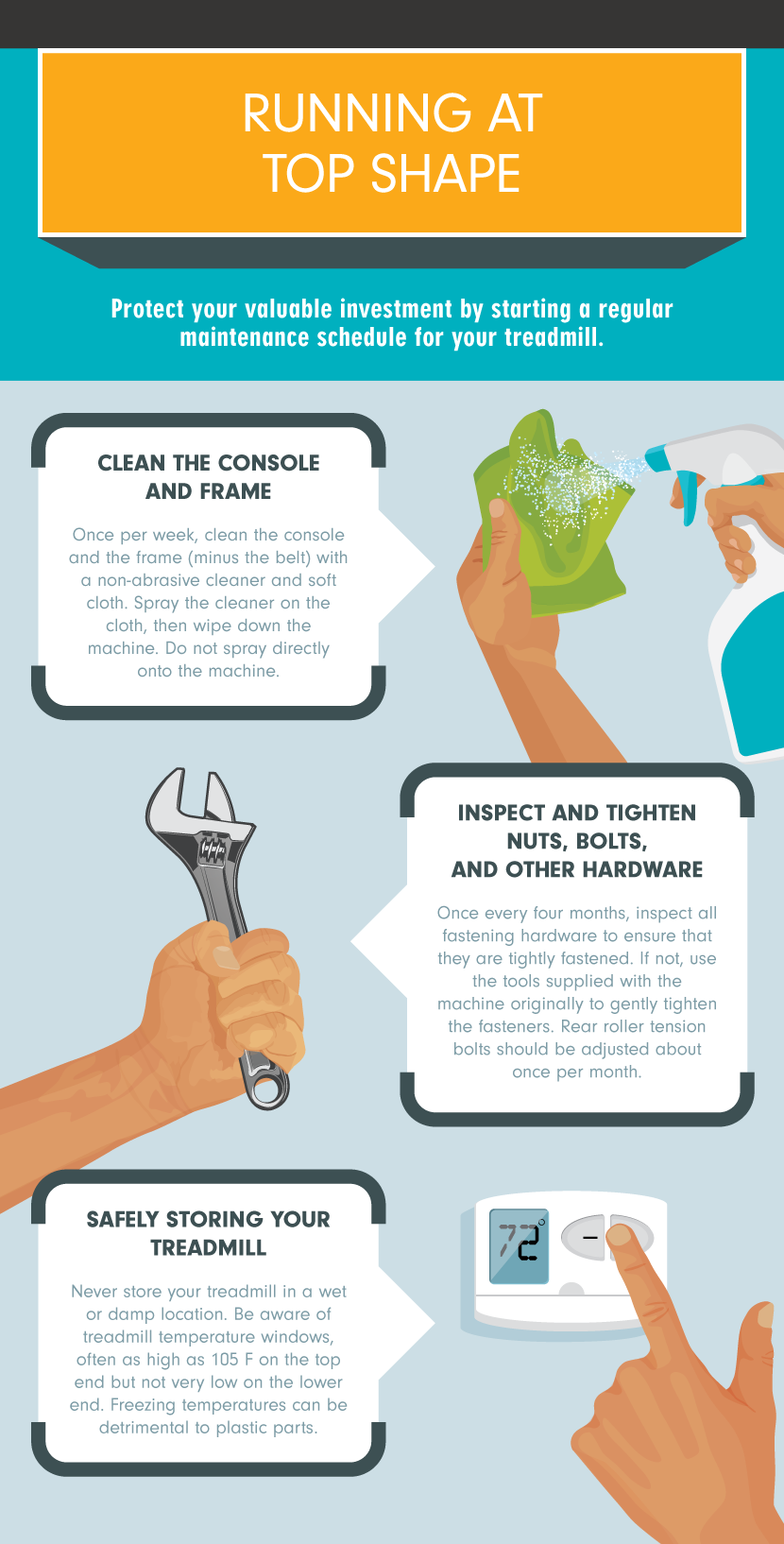Guide to Common Treadmill Repairs and Maintenance
Is your treadmill broken or not functioning properly? Like it or not, this is no excuse for putting your exercise routine on hiatus. A non-functioning or poorly functioning treadmill does not always mean that you have to call in a pricey exercise-equipment technician. Instead, this simple machine has a set of parts which are easy to comprehend by most do-it-yourselfers, and just as easy to repair.
Understanding Your Treadmill & Repair 101
Treadmills can be a fantastic way to get exercise when and where you thought exercise was not previously possible. Usually located in a spare bedroom, garage, or fitness room, treadmills allow you to ignore inclement weather while maintaining your fitness schedule.
If you already have a treadmill, you know its many benefits. But do you know how it really works? Before you can efficiently and safely repair your machine, understand a few aspects of its operation:
Electrically Operated
Most treadmills are not manually operated (though a few are). When users walk, the machine typically uses 2 horsepower (hp). Running means that the treadmill’s motor must step up to about 3 hp. Heavier users tax the motor even more. For users over 200 pounds, the machine works about 0.5 hp harder.
Safety Key
Today, most treadmills only operate when a safety key is inserted into the console. The other end of the nylon lanyard attaches to your shirt. If you should stumble and fall, the key pulls out and rapidly stops the belt movement, avoiding further injury. One tip for preventing children from being injured on treadmills is to remove and hide the safety key when not in use. Without the key, children cannot turn on the treadmill.
Five Main Elements
No matter how many improvements have been made over the years, treadmills still only have five basic groups of parts:

Staying Safe on Your Treadmill
High-profile injuries have created the perception that treadmills are inherently unsafe. Facebook CEO Sheryl Sandberg’s husband died on a treadmill. The New York Mayor’s press secretary Karen Hinton suffered major injuries in a treadmill accident.
But these are extremely rare cases: the U.S. Consumer Product Safety Commission reports only sixty deaths on treadmills in a twelve-year span. Most are minor strains and bumps.
If you follow safety procedures, you should be fine. Make sure that the machine is not running when you get on it. Use, but do not rely on, the safety rails. Attach the safety key to yourself. Do not go past a comfortable speed. Look forward, not at your feet. And never step off of a moving treadmill.Treadmill Injuries - http://www.nydailynews.com/news/national/serious-treadmill-injuries-karen-hinton-rare-article-1.3039428Treadmill Safety - http://www.treadmillreviews.net/9-tips-for-treadmill-safety/
Repair Safety Issues
Before making repairs on your treadmill, be sure to unplug the treadmill from its power source. You risk serious injury if you work on a treadmill that suddenly starts up again. To increase your margin of safety, also remove the emergency safety key from the console.
Tools That You May Want:
- 100% Silicone Lubricant
- Soft Cotton Cloth
- Non-Abrasive Cleaner
- Set of Regular Allen Wrenches
- Replacement Large T-shaped Allen wrench for Adjusting Rear Roller (if not provided with your machine, seek a replacement for this)
Extra or Replacement Parts That You May Want
- Power Cord Replacement
- Extra Safety Key
- Drive Motor Belt
- Console Wire
- Treadmill Belt
- Roller Pulley

Fixing Treadmill Belt Problems
The walking/running belt is the heart and soul of your treadmill. Second to the motor, the belt performs the most work and takes the greatest amount of abuse. Consequently, this is where most of the problems will occur.
Belt Too Loose or Tight
One rule of thumb to determine if your belt is the right tightness is to lift the side of the belt, around the middle of the belt, and you should be able to lift it about two or three inches. If you cannot lift it this high, the belt is too tight: if the belt is so loose that you can reach your entire hand underneath the center area, it is too loose.
Rarely is a stretched-out belt the cause of a slipping belt. Instead, the issue may be that the rear roller needs adjustment. Use the large T-shaped Allen wrench and tighten the rear tension bolts about one-quarter turn. If the belt is too tight, loosen it by about a one-quarter turn.Belt Tight/Loose - https://www.treadmilldoctor.com/treadmill-belt-slipping
Belt Uncenters Itself
The cause of the belt uncentering itself is usually that the rear rollers are not aligned. This is one repair that you will need to undertake while the unit is plugged in and turned on.
- Turn on the treadmill to the slowest speed possible.
- Go behind the machine and insert the large T-shaped Allen wrench in one of the rear tension bolts.
- Turn it either left or right by a one-quarter turn and observe how the belt tracks, left or right.
- Adjust that bolt in conjunction with its partner (on the other side) to achieve perfect centering.
- Walk on the treadmill for three minutes to ensure that the belt remains centered under normal conditions.Belt Centering - http://world.horizonfitness.com/docs/belt-tension-aligning.pdf
Lubricate Your Treadmill Belt
- When lubricating your belt, make sure that you do not get any of the lubricant on the walking/running surface as this can cause you to slip later
- Grasp one side of the belt and pull it up and slightly away. Insert the silicone spray nozzle underneath and spray towards the center area. Do this on the other side as well.
- Manually move the belt about half a revolution and lubricate in the same manner again.
- When finished, run the treadmill at a slow walking pace for about five minutes to evenly distribute the lubricant.Lubricate the Belt - https://www.lifespanfitness.com/fitness/resources/articles/how-to-lubricate-your-treadmill-belt
Problems with the Treadmill Motor/Power Drive
Along with the treadmill belt, the motor works hard to keep you in shape. As a result, you can expect that issues will eventually develop in the motor and power drive area.
Treadmill Will Not Turn On/Off
One common reason for treadmills that refuse to power on: the machine is plugged into a GFCI (ground fault current interrupter) outlet which has tripped off. Reset the outlet and the machine should turn on again.
If power from the outlet is live, check to see if the console powers on. If not, unplug the machine, then remove the motor hood and check for loose pin connections and any unattached wires. If wires appear to be attached, unplug the plastic connectors and plug them in again to see if that does the trick.
Burning Smell
When you smell burning rubber, this may not necessarily be a motor issue. Instead, an over-tightened belt may be dragging across the treadmill deck, causing friction and the burning smell. The cure for this is to lubricate or loosen the belt.
If that does not help, unplug the machine and remove the motor housing. If any of the moving parts in the motor area – such as the drive belt and pulleys – are producing the smell, they should be replaced.8. Burning Smell - http://www.treadmillreviews.net/how-to-fix-common-treadmill-problems/
Erratic Speed
Movement issues can be either mechanical or electrical. Test whether the cause is mechanical by turning off the machine and walking on the belt. It should move with more difficulty than if the motor were running: yet it should still move and even continue for a few inches after each step. If the cause is mechanical, then lubricate the belt or adjust tension bolts.
You can also remove the motor housing and check the drive belt and plastic roller pulley. If the drive belt is not adequately gripping on the roller, power will not be transferred and speed will be lost.

Maintaining Your Treadmill for the Long-Term
Protect your valuable investment by starting a regular maintenance schedule for your treadmill. After all, it is much easier to perform minor maintenance duties than it is to repair a broken machine. This regimen should include:
Cleaning the Console and Frame
If you use the treadmill around three to four times per week, clean the console and frame (minus the belt) with a non-abrasive cleaner and soft cloth about once a week. Spray the cleaner on the cloth, then wipe down the machine. Do not spray directly onto the machine.
Inspect and Tighten Nuts, Bolts, and Other Hardware
Treadmills are meant to take a pounding. This means that, over time, even the best-engineered treadmill will begin to come apart, ever so slowly. Specifically, bolts will begin to unscrew under the extreme forces of the treadmill. Once every four months, inspect all fastening hardware to ensure that they are tightly fastened. If not, use the tools originally supplied with the machine to gently tighten the fasteners.
Rear roller tension bolts should be adjusted about once per month.
Storing Your Treadmill
Never store your treadmill in a wet or damp location. Be aware of treadmill temperature windows. If the temperature is less or greater than the manufacturer’s suggested range, then adjust the temperature accordingly or move the treadmill to a safer area. Usually, temperature windows are quite generous on the high end (105 degrees F or so) but less so on the lower end, with freezing temperatures detrimental to plastic parts.Long-Term Maintenance - https://support.nordictrack.com/regular-maintenance/
Treadmills can be a safe, fun way to meet your exercise goals at home. Learn how to repair and maintain your treadmill for the long term with this guide.
Embed the article on your site

